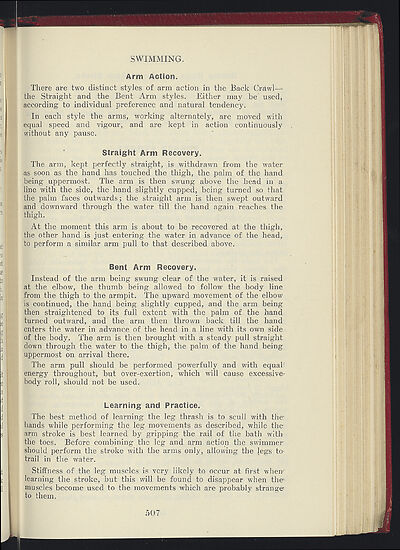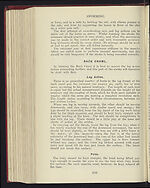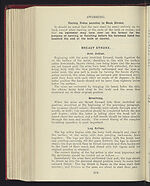1935-36
(555)
Download files
Complete book:
Individual page:
Thumbnail gallery: Grid view | List view

T
ie
it
�e
to
s
e
a
h
n
d
it
e
;t
d
d
11
t
SWIMMING.
Arm Action.
There are two distinct styles of arm action in the Back Crawl—=
the Straight and the Bent Arm styles. Either may be' used,
according to individual preference and natural tendency.
In each style the arms, working alternately, are moved with
equal speed and vigour, and are kept in action continuously
without any pause.
Straight Arm Recovery.
The arm, kept perfectly straight, is withdrawn from the water
as soon as the hand has touched the thigh, the palm of the hand
being uppermost. The arm is then swung above the head in a
line with the side, the hand slightly cupped, being turned so that
the palm faces outwards; the straight arm is then swept outward
and downward through the water till the hand again reaches the
thigh.
At the moment this arm is about to be recovered at the thigh,
the other hand is just entering the water in advance of the head,
to perform a similar arm pull to that described above.
Bent Arm Recovery.
Instead of the arm being swung clear of the water, it is raised
at the elbow, the thumb being allowed to follow the body line
from the thigh to the armpit. The upward movement of the elbow
is continued, the hand being slightly cupped, and the arm being
then straightened to its full extent with the palm of the hand
turned outward, and the arm then thrown back till the hand
enters the water in advance of the head in a line with its own side
of the body. The arm is then brought with a steady pull straight.
down through the water to the thigh, the palm of the hand being
uppermost on arrival there.
The arm pull should be performed powerfully and with equal;
energy throughout, but over-exertion, which will cause excessive-
body roll, should not be used.
Learning and Practice.
The best method of learning the leg thrash is to scull with the
,
hands while performing the leg movements as described, while the
arm stroke is best learned by gripping the rail of the bath with
the toes. Before combining the leg and arm action the swimmer
,
should perform the stroke with the arms only, allowing the legs to
,
trail in the water.
Stiffness of the leg muscles is very likely to occur at first when
learning the stroke, but this will be found to disappear when the
,
muscles become used to the movements which are probably strange.
to them.
5()7
q
ie
it
�e
to
s
e
a
h
n
d
it
e
;t
d
d
11
t
SWIMMING.
Arm Action.
There are two distinct styles of arm action in the Back Crawl—=
the Straight and the Bent Arm styles. Either may be' used,
according to individual preference and natural tendency.
In each style the arms, working alternately, are moved with
equal speed and vigour, and are kept in action continuously
without any pause.
Straight Arm Recovery.
The arm, kept perfectly straight, is withdrawn from the water
as soon as the hand has touched the thigh, the palm of the hand
being uppermost. The arm is then swung above the head in a
line with the side, the hand slightly cupped, being turned so that
the palm faces outwards; the straight arm is then swept outward
and downward through the water till the hand again reaches the
thigh.
At the moment this arm is about to be recovered at the thigh,
the other hand is just entering the water in advance of the head,
to perform a similar arm pull to that described above.
Bent Arm Recovery.
Instead of the arm being swung clear of the water, it is raised
at the elbow, the thumb being allowed to follow the body line
from the thigh to the armpit. The upward movement of the elbow
is continued, the hand being slightly cupped, and the arm being
then straightened to its full extent with the palm of the hand
turned outward, and the arm then thrown back till the hand
enters the water in advance of the head in a line with its own side
of the body. The arm is then brought with a steady pull straight.
down through the water to the thigh, the palm of the hand being
uppermost on arrival there.
The arm pull should be performed powerfully and with equal;
energy throughout, but over-exertion, which will cause excessive-
body roll, should not be used.
Learning and Practice.
The best method of learning the leg thrash is to scull with the
,
hands while performing the leg movements as described, while the
arm stroke is best learned by gripping the rail of the bath with
the toes. Before combining the leg and arm action the swimmer
,
should perform the stroke with the arms only, allowing the legs to
,
trail in the water.
Stiffness of the leg muscles is very likely to occur at first when
learning the stroke, but this will be found to disappear when the
,
muscles become used to the movements which are probably strange.
to them.
5()7
q
Set display mode to:
![]() Universal Viewer |
Universal Viewer | ![]() Mirador |
Large image | Transcription
Mirador |
Large image | Transcription
| Games and sports in the army > 1935-36 > (555) |
|---|
| Permanent URL | https://digital.nls.uk/248715585 |
|---|
| Description | 'Games and Sports in the Army' was an annual publication produced by the British War Office between the 1930s and 1960s. This included the Second World War. It outlines the rules and regulations for games and sports played by members of the armed forces. It features names and photographs of team members, and examples of contemporary advertising. |
|---|---|
| Shelfmark | GWB.52 |

